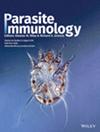Trichinella spiralis nurse cell formation is regulated via CCR7+ dendritic cells
IF 1.4
4区 医学
Q4 IMMUNOLOGY
引用次数: 0
Abstract
The chemokine receptor CCR7 is a well‐established homing receptor for dendritic cells (DCs) and T‐cells. Interaction with the CCL19 and CCL21 ligands promotes priming of immune responses in lymphoid tissues; however, the mechanism underlying CCR7‐induced immune responses against helminth parasite infection remains unknown. Thus, we examined the role of CCR7 in generating protective immune responses against intracellular Trichinella spiralis infection. The results showed significantly increased CCR7, CCL19 and CCL21 expression in the muscle tissue compared to that in the intestinal tissue in T. spiralis‐infected mice. The CCR7‐expressing DC population increased in the mesenteric and peripheral lymph nodes (PLNs) during T. spiralis infection. Notably, the number of CCR7‐expressing cells in PLNs increased by more than 30% at 28 days post‐infection; however, this increase was significantly inhibited in CCR7‐blocked mice treated with CCR7‐specific antibodies. T helper 2 (Th2)‐and regulatory T (Treg)‐related cytokine levels were also reduced by CCR7‐specific antibody treatment. CCR7‐blocked mice lost their resistance to T. spiralis infection in the muscle phase but not in the intestinal phase. Furthermore, fewer eosinophils around the nurse cells and reduced total and T. spiralis‐specific IgE in the serum were observed in CCR7‐blocked mice compared to those infected with only T. spiralis. CCR7 blockade led to the T. spiralis infection‐induced suppression of Th2‐ and Treg‐related cytokine production in vitro. These results suggest that CCR7 in DCs might play an essential role in host defence mechanisms against T. spiralis infection, particularly in the muscle stage of the infection, by accelerating Th2 and Treg cell responses.旋毛虫乳突细胞的形成是通过CCR7+树突状细胞调控的
趋化因子受体CCR7是树突状细胞(dc)和T细胞的一种成熟的归巢受体。与CCL19和CCL21配体的相互作用促进淋巴组织免疫应答的启动;然而,CCR7诱导的针对寄生虫感染的免疫应答机制尚不清楚。因此,我们研究了CCR7在产生针对胞内旋毛虫感染的保护性免疫应答中的作用。结果显示,CCR7、CCL19和CCL21在螺旋体感染小鼠肌肉组织中的表达明显高于肠道组织。在螺旋体感染期间,肠系膜和外周淋巴结(pln)中表达CCR7‐的DC群体增加。值得注意的是,感染后28天,pln中表达CCR7的细胞数量增加了30%以上;然而,在用CCR7特异性抗体处理的CCR7阻断小鼠中,这种增加被显著抑制。CCR7特异性抗体治疗也降低了T辅助2 (Th2)‐和调节性T (Treg)‐相关的细胞因子水平。CCR7阻断小鼠在肌肉期失去了对螺旋体感染的抵抗力,但在肠道期没有。此外,与仅感染螺旋体的小鼠相比,CCR7阻断小鼠护理细胞周围的嗜酸性粒细胞减少,血清中总IgE和螺旋体特异性IgE减少。CCR7阻断导致螺旋体感染诱导的Th2 -和Treg -相关细胞因子的体外抑制。这些结果表明,dc中的CCR7可能通过加速Th2和Treg细胞反应,在宿主抵抗螺旋体感染的防御机制中发挥重要作用,特别是在感染的肌肉阶段。
本文章由计算机程序翻译,如有差异,请以英文原文为准。
求助全文
约1分钟内获得全文
求助全文
来源期刊

Parasite Immunology
医学-寄生虫学
CiteScore
4.70
自引率
4.50%
发文量
61
审稿时长
6-12 weeks
期刊介绍:
Parasite Immunology is an international journal devoted to research on all aspects of parasite immunology in human and animal hosts. Emphasis has been placed on how hosts control parasites, and the immunopathological reactions which take place in the course of parasitic infections. The Journal welcomes original work on all parasites, particularly human parasitology, helminths, protozoa and ectoparasites.
 求助内容:
求助内容: 应助结果提醒方式:
应助结果提醒方式:


